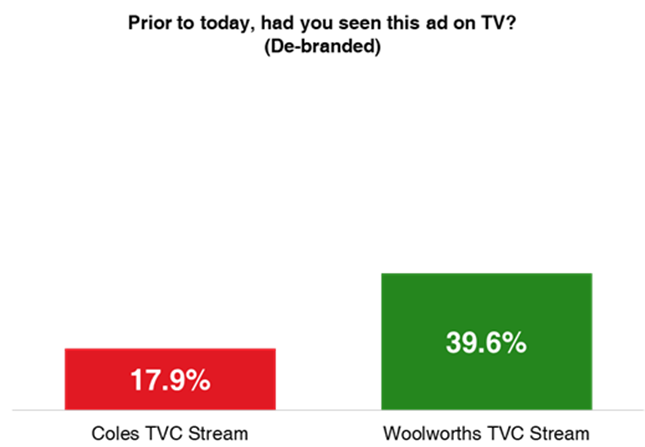This is an evidence-based reminder that the use of distinctive assets, nurtured over time can produce stunning results
Brand Strategy, Creative Efficacy
Has Woolworths Provided an Advertising Masterclass in the Power of Distinctive Brand Assets?
Posted 29 Oct 2021According to new advertising analysis from Forethought, the supermarket giant’s ‘Today’s Fresh Food People’ campaign proves the necessity of leveraging distinctive brand assets[1], with close to 9 in 10 Australian consumers connecting the ad to their brand following a test.
Woolworths’ new ‘Today’s Fresh Food People’ TV commercial (produced by M&C Saatchi) is an overtly ‘green’ execution (both in sentiment and colour), underpinned by the distinctive ‘Woolies’ jingle with messaging focused on the freshness and quality of their products, as their now slightly reimagined 30+ year old slogan suggests. New analysis from Forethought, which was not commissioned by either brand, tested the application of distinctive assets in advertising, using a set of de-branded stills from the commercial as stimulus (more detail below). The study demonstrated that the consistent deployment of the uniquely ‘Woolies’ brand assets mentioned above throughout the ad registered with consumers – achieving what all good advertising should do (even without explicit branding): connect the audience to the (correct) brand.
To conduct and contextualise the ad test, Forethought examined Woolworths’ latest commercial, in comparison with Coles’ advertising, which were both launched at the same time (Aug 2021).
Coles’ ‘Together to Zero’ commercial emphasised their commitment to and encouragement of environmentally sustainable practices, reaffirming ambitious targets to reduce CO2 emissions and ‘to become Australia's most sustainable supermarket'.
The research found that the latest anthemic brand advertising campaigns from Australia’s two leading supermarket chains, which differ markedly in the degree to which they utilise branded cues, yielded significantly different results following Forethought’s test of consumer recognition and recall.
ABOUT THE ‘DISTINCTIVE BRAND ASSETS IN ADVERTISING’ RESEARCH
To test the effectiveness of both the Woolworths and Coles TV ads (ie. their likelihood to be recognised, associated with the brand in question and recalled), Forethought showed a representative sample of 800 Australian consumers de-branded stills taken from each advertisement, pictured below.
It was a concern that showing frames rather than the full advertisement excluding branding would have disadvantaged the Woolworths ad, because their highly recognisable audio asset/jingle could not be included in the stimulus (and this was identified prior to the study as a potential limitation). However, the strong utilisation of other distinctive Woolworths brand assets overcame this hurdle, with the commercial scoring very high on both recognition and brand association.
[1] Distinctive brands assets enable an ad to be recognised and linked to its origin. Its advertising 101. For example, the YES logo for Optus. If Australians were just shown the stylised YES logo, 95% spontaneously recognise it as an Optus ad. The Coles ad lacks distinctive brand assets causing a very large proportion of the prospective audience to misattribute the origin.

DE-BRANDED TVC TEST BOARDS: WOOLWORTHS

DE-BRANDED TVC TEST BOARDS: COLES
After viewing the stimulus, respondents were then asked a series of questions associated with recognition and recall. The results demonstrated the depth of Woolworths’ successful utilisation of their distinctive brand assets:


Despite the spots being de-branded during the test, the results are in stark contrast to one another with the Woolworths ad clearly and significantly outperforming the Coles ad on correct brand association.
The Woolworths stimulus was correctly linked to the Woolworths brand for the clear majority at 88.8% (with 1.2% misattributing the ad to its main competitor and only 7.5% unsure who was behind the advertising).
By contrast, the Coles stimulus proved more difficult for consumers to match to Coles at only 20.9% (with 7.2% misattributing the ad to its main competitor and, of probably far greater concern, was the 59.8% of consumers who were unable to determine which brand was behind the ad).
Using an array of distinctive brand assets such as colour, gingham check uniform and images of ‘on message’ produce - the Woolworths ad proved to be strongly effective at driving brand recognition, with close to 9 in 10 consumers recognising and associating the piece correctly with the brand.
Forethought Global CEO Darren Stein said of the findings: “Woolworths’ consistent and clever use of distinctive assets and recognition triggers were clearly rewarded as shown by the results in the study. Their success on this occasion is also amplified by the relatively weaker results from their major competitor.
This is an evidence-based reminder that the use of distinctive assets, nurtured over time can produce stunning results, not only against newcomers invading an established category, but also as is the case here, in the largest, longest standing and most competitive of marketing arenas”.
ABOUT THE RESEARCH
The Forethought advertising performance methodology employed to arrive at the results in this release is based on over 15 years of customer research.
Forethought surveyed over 800 Australians to arrive at these results with over 400 viewing the advertisement for each brand:
Coles TVC Stream n=401
Woolworths TVC Stream n=402
ABOUT FORETHOUGHT
Forethought is a leading customer and marketing analytics and strategy advisory firm.
Forethought, with the largest marketing science team in Australia, partners 80 clients in Australia to drive customer and market share growth via providing the evidence and CMO advisory support focused on customer acquisition and retention strategy and market share growth. In North America, Forethought partners with the fastest growing airline, JetBlue as well as several category leading brands.
 Marketing Advisory, Strategy and Analytics
Marketing Advisory, Strategy and Analytics
